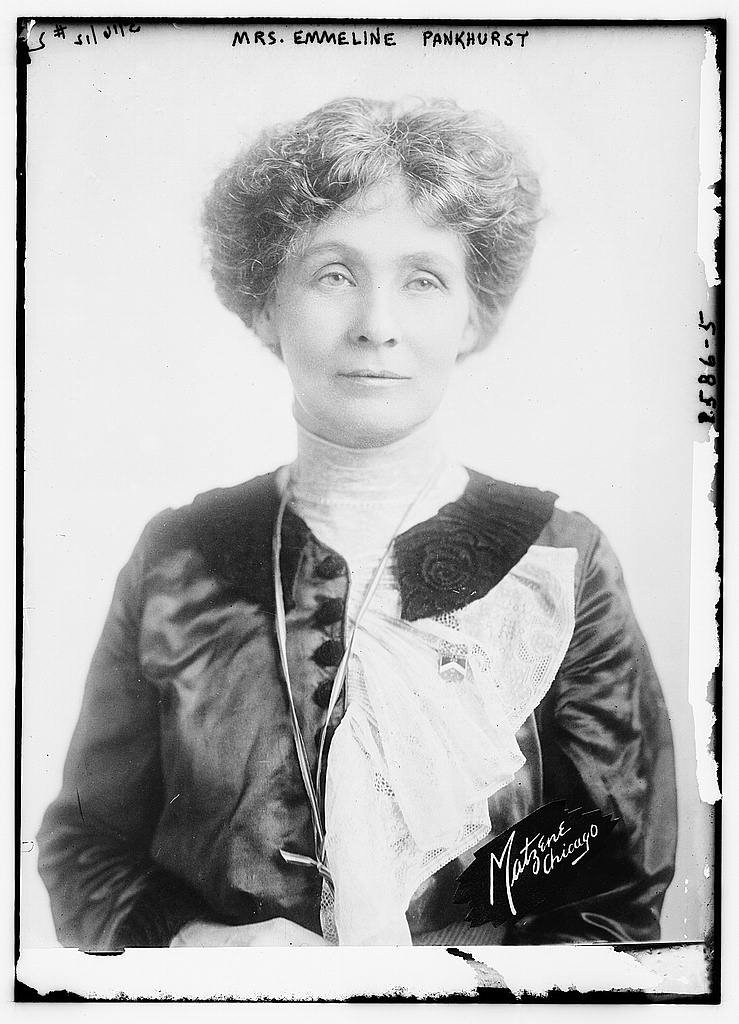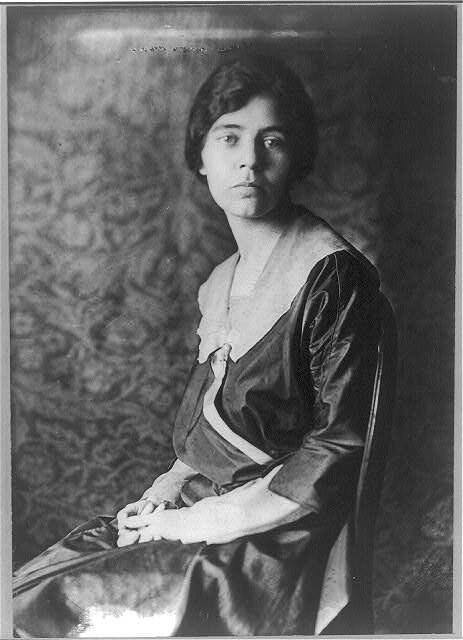Suffragette & Suffragist: The Influence of the British Suffrage Movement

Emmeline Pankhurst (Library of Congress)
“I am what you call a hooligan,” Emmeline Pankhurst announced to the standing-room only crowd of women packed into Carnegie Hall in October 1909. Hundreds more gathered outside, hoping to hear the famous “suffragette” speak. The American suffrage and labor activists in attendance cheered as Mrs. Pankhurst regaled the audience with stories about the fight to win the vote for British women. Although the tactics of the Women’s Social and Political Union (WSPU), led by Pankhurst and her daughters, were often discredited in the United States as too militant, on that night, her testimony met with approval.[1] While the crowd at the New York City event applauded and sang suffrage anthems, across the Atlantic a young American named Alice Paul was gaining national attention for her participation in the WSPU’s confrontational demonstrations.
Alice Paul was first inspired to join the suffrage cause while in graduate school in England. In November 1907, when she was a student at Birmingham University, she attended a rousing lecture by Christabel Pankhurst, daughter of Emmeline, in support of women’s enfranchisement. Paul was particularly inspired by Christabel’s grace and poise in response to the taunts of male students.[2] Alice then enrolled at the London School of Economics; she participated in two suffrage marches that summer. The first was planned by the more reserved National Union of Women’s Suffrage Societies (NUWSS) led by Millicent Fawcett. Although Alice enjoyed the pageantry of the NUWSS procession, it was the larger WSPU march a week later that made her a recruit. She was thrilled by the military precision of the event. Battalions of marchers wearing white and carrying banners, flags, and pennants of purple and green set out from points around the city and converged at Hyde Park. Presenters stationed around the park electrified the crowds of more than 30,000. At the sound of triumphant bugles, the participants all joined together in a final cry of “Votes for Women! Votes for Women!” Even the anti-suffrage New York Times praised the “genius for organization” on display.[3] Alice Paul was in; she became a suffragette.
Over the next several months, Alice participated in increasingly risky activities in support of women’s suffrage in Britain. She started by selling the WSPU’s newspaper Votes for Women on street corners, which often meant enduring verbal abuse. She moved on to giving speeches at outdoor meetings. Speakers were regularly assaulted and pelted with stones for transgressing social norms governing women’s behavior in public.[4] As her confidence as a speaker increased, so did her willingness to face greater danger. She was arrested for the first time during a massive WSPU protest on June 29, 1909, in which thousands of women in multiple deputations approached Parliament Square. As police halted each group and arrested the women, the next deputation stepped up with the same demands to be heard.[5] Alice continued to plan and participate in demonstrations across England and Scotland, enduring five more arrests that year and three prison terms.[6]

Official Program of the 1913 Suffrage Parade (Library of Congress)
Although the American press mistakenly credited Alice with the innovation of the hunger strike, suffragette Marion Dunlop was the first to refuse food after demanding political prisoner status.[7] Alice and her fellow suffrage prisoners followed suit during their incarcerations, refusing to eat or to wear prison clothes. Alice spent at least one 5-day sentence in solitary confinement, naked except for a blanket. Initially, British officials released the hunger strikers as their health began to fail. By the time of her final U.K. imprisonment in November 1909, however, Alice and her comrades faced a new terror: forcible feeding.[8]
While Emmeline Pankhurst toured the United States in the fall of 1909, American newspapers carried stories about the horrors that Alice Paul was facing in London’s Holloway prison. Women who had been incarcerated with her shared harrowing stories of Alice’s cries echoing through the prison as she was force-fed more than fifty times.[9] Upon her release, Alice gave her own account to reporters. “Twice a day for the month that I spent in Holloway prison in London I was strapped and bound round with sheets until I could not move a muscle,” she reported. “Then another sheet was bound round my throat to keep my neck rigid and the torture began. A long glass tube, bent at the end and as thick as my thumb, was forced through my nostrils and the liquid food poured in. The pain was intense, but I would not give in.”[10]
When Alice Paul returned to the United States in 1910, she used her experiences as a British suffragette to re-energize the American suffrage movement. She began by recreating the sense of pageantry she had experienced during the 1909 WSPU march. The 1913 Woman Suffrage Procession down Pennsylvania Avenue on the day before Woodrow Wilson’s inauguration announced a new focus on a federal amendment to win the vote. Alice Paul used the organizational skills she developed while planning similar events for the WSPU to bring thousands of women from around the country to participate.[11] Through the years, she continued to design campaigns and publicity stunts with the same kind of political savvy that the Pankhursts had mastered.

Alice Paul (Library of Congress)
After Alice Paul returned to the United States, the WSPU tactics in Britain grew more violent. Suffragettes set fires, slashed paintings, broke windows, and committed other acts of property destruction. Alice Paul and her suffrage organization, the National Woman’s Party (NWP), were considered militant and radical although they never engaged in that level of violence. Alice was willing to confront power, violate social expectations of proper womanly behavior, and face arrest, just as she had during her time with the WSPU. Although many scholars attribute Alice’s reluctance to use more destructive tactics to her religious upbringing as a Quaker, Alice credited her strategy to political calculations. “Here men do not throw stones through windows to accomplish their purpose. They organize and form a machine. And that is what we must do to accomplish the establishment of equal suffrage,” she told her fellow suffragists. When a reporter pressed her about her history in the U.K., she declared “If it becomes necessary to fight to win, I believe in fighting.”[12]
Alice Paul also drew upon the example of the less-violent Women’s Franchise League (WFL) when designing strategies to win the vote. The 1917 Silent Sentinel picket campaign of the White House resembled the WFL’s “Siege of Westminster” in 1909. During the Siege, women stood peacefully outside Parliament and 10 Downing Street and were arrested for blocking the entrance.[13] When the NWP continued the 1917 protest at the White House after the U.S. entered World War I, the pickets, including Alice Paul, were arrested for “obstructing the sidewalk.” [14]
Like the suffragettes in the U.K., NWP prisoners also demanded political prisoner status and went on hunger strikes to protest their conditions. The hunger strikers, including Alice Paul, endured forced feedings. The NWP organized a protest of Alice Paul’s imprisonment on November 10, 1917, using a similar playbook as the 1909 WSPU petition of Parliament. A delegation of 41 demonstrators, organized by state into five divisions, marched to the White House carrying banners demanding the President’s support for the Constitutional amendment. The first group approached the east gate and were ordered by the police to "move on." The women refused and were arrested. A second group advanced to the west gate and were also detained. The march continued, alternating between the two gates, until all 41 were taken into custody. The publicity surrounding the demonstration, as well as reports of the brutality the suffragists endured in prison, kept the issue of women’s suffrage on the front pages even during wartime.[15]
When Woodrow Wilson began to support passage of the federal women’s suffrage amendment in 1918, he denied that the NWP campaigns had influenced his decision.[16] Whether or not she was responsible for his change of heart, Alice Paul had successfully adapted the militant strategies of the British suffragettes to convince Americans of the urgency of “Votes for Women!”
Author Biography
Susan Philpott is a Park Ranger with the National Park Service at the Belmont-Paul Women’s Equality National Monument, historic headquarters of the National Woman’s Party. She earned her Bachelor and Master of Arts degrees in Historical Studies, with a focus on Public History, at the University of Maryland, Baltimore County (UMBC). Her areas of study include the long Civil Rights Movement and Black freedom struggle, especially in Washington, D.C. She continues her research into strategies used by those who demand social, political, and economic equality.
Bibliography
Bolt, Christine. “America and the Pankhursts,” in Votes for Women: The Struggle for Suffrage Revisited. Ed. Jean H, Baker. New York: Oxford University Press, 2002.
Ford, Linda. “Alice Paul and the Politics of Nonviolent Protest,” in Votes for Women: The Struggle for Suffrage Revisited. Ed. Jean H, Baker. New York: Oxford University Press, 2002.
“Girl’s Ordeal in Jail: Miss Paul Tells Horrors of the Feeding Tube,” Washington Post, 6 Feb 1910, A7.
“Great Throng Hears Mrs. Pankhurst,” New York Times, 26 Oct 1909.
“Harsh to Yankee Girl: Women Warders Call Men to Put Her in Prison Garb, Feed Her Through Pump,” Washington Post, 21 Nov 1909, 13.
Stevens, Doris. Jailed for Freedom. New York: Boni & Liveright, Inc., 1920.
“Suffragettes’ New Fashion: Refuse to Put on Prison Garb, and Hence They Wear Nothing,” Washington Post, 19 Nov 1909, 1.
“Two Americans in Guildhall Exploit,” New York Times, 12 Nov, 1909.
Zahniser, J. D. and Amelia R. Fry. Alice Paul: Claiming Power. New York: Oxford University Press, 2014.
[1] Christine Bolt, “America and the Pankhursts,” in Votes for Women: The Struggle for Suffrage Revisited, ed. Jean H, Baker (New York: Oxford University Press, 2002), 148-149; J. D. Zahniser and Amelia R. Fry, Alice Paul: Claiming Power (New York: Oxford University Press, 2014), 97; “Great Throng Hears Mrs. Pankhurst,” New York Times, 26 Oct 1909, 1.
[2] Zahniser and Fry, 46-47.
[3] Zahniser and Fry, 52-53.
[4] Zahniser and Fry, 59-61.
[5] Zahniser and Fry, 67-71.
[6] Zahniser and Fry, 70-96.
[7]“Two Americans in Guildhall Exploit,” New York Times, 12 Nov, 1909, 1; Zahniser and Fry, 72.
[8] Zahniser and Fry, 82-85, 93.
[9] “Suffragettes’ New Fashion: Refuse to Put on Prison Garb, and Hence They Wear Nothing,” Washington Post, 19 Nov 1909, 1; “Harsh to Yankee Girl: Women Warders Call Men to Put Her in Prison Garb, Feed Her Through Pump,” Washington Post, 21 Nov 1909, 13; Zahniser and Fry, 98-101.
[10] “Girl’s Ordeal in Jail: Miss Paul Tells Horrors of the Feeding Tube,” Washington Post, 6 Feb 1910, A7.
[11] Zahniser and Fry, 86, 89-90, 144-146.
[12] Alice Paul, quoted in Zahniser and Fry, 107, 110.
[13] Zahniser and Fry, 73-4.
[14] Linda Ford, “Alice Paul and the Politics of Nonviolent Protest,” in Votes for Women, 179-181; Zahniser and Fry, 255-257, 281.
[15] Doris Stevens, Jailed for Freedom (New York: Boni & Liveright, Inc., 1920), 192-6; Zahniser and Fry, 291-2.
[16] Zahniser and Fry, 308.
